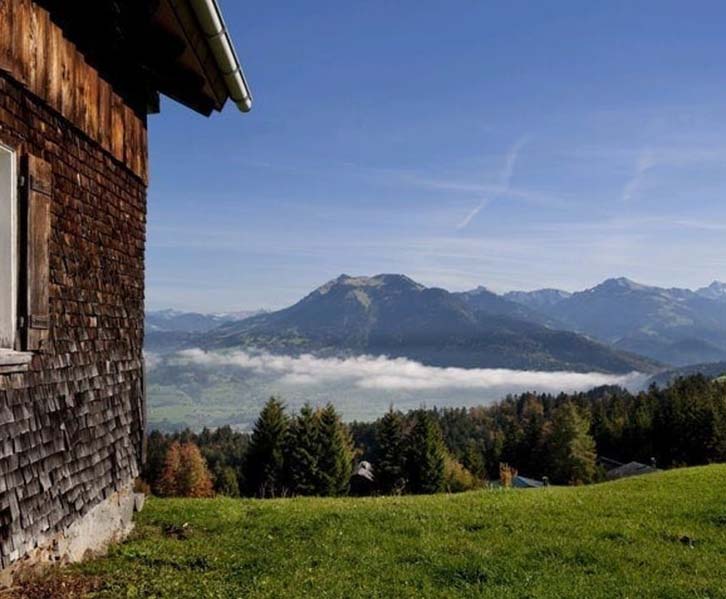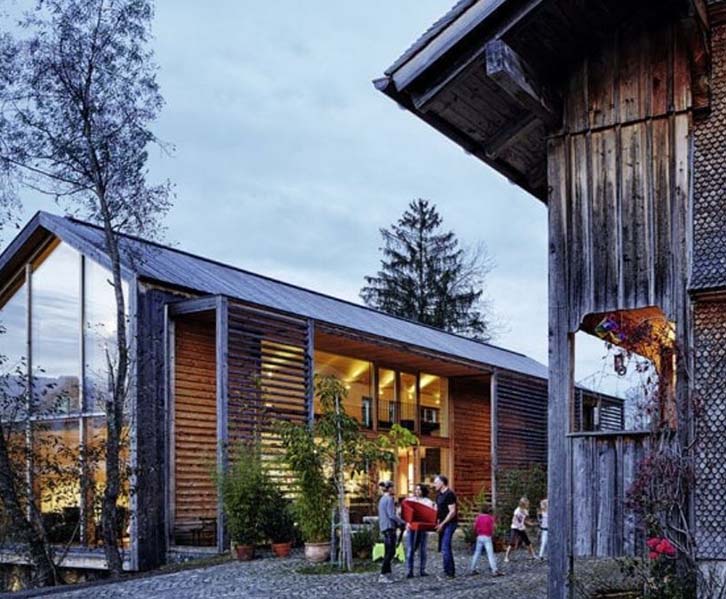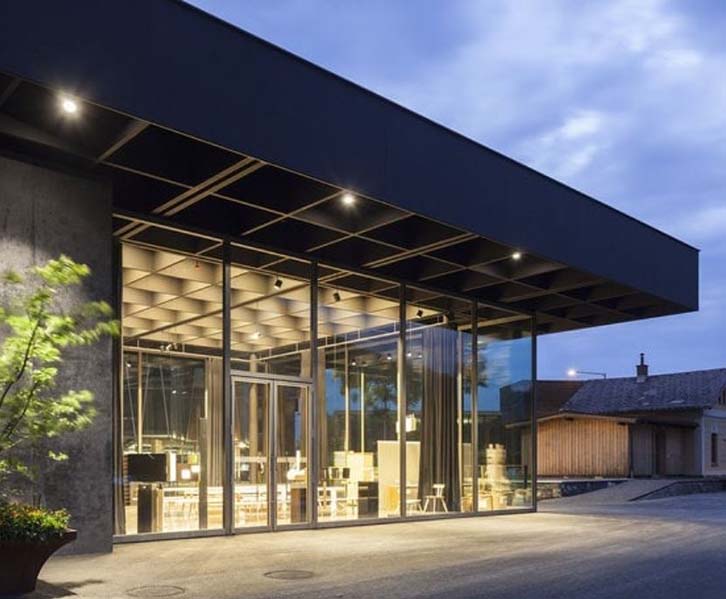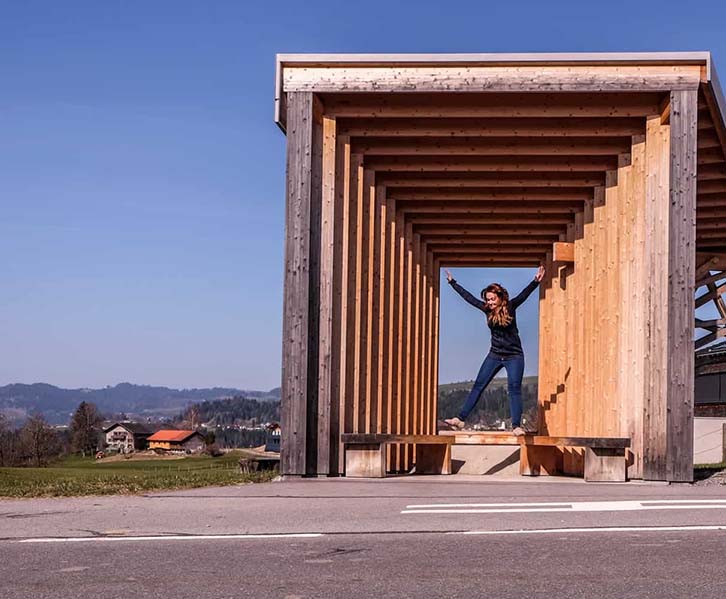Bregenzerwald. You may not be familiar with it. It’s a compact area located in Vorarlberg, the Alpine region of western Austria. Predominantly rural, with quaint villages and expansive natural landscapes, it might be one of the least expected locations for a thriving contemporary art scene.
However, these picturesque terrains are gaining recognition for more than just their ski resorts and hiking trails. Vorarlberg is leading the way in modern design and architecture and has been drawing global attention for some time. Bregenzerwald, in particular, offers an ideal opportunity to explore some of the region’s artistic gems.

The Bregenzerwald region, tucked away in the scenic Vorarlberg province of western Austria, may not be a household name, but it’s a place where rural charm and artistic innovation converge in delightful harmony. Despite its predominantly pastoral character, this compact area has emerged as an unexpected hub for contemporary art and design. Here, amid the quaint villages and expansive natural landscapes, you’ll find a thriving cultural scene that transcends the traditional Alpine pursuits of skiing and hiking.
Vorarlberg, the broader Alpine region in which Bregenzerwald is nestled, has been at the forefront of the modern design and architectural movement, drawing international acclaim for its innovative approach. Bregenzerwald, in particular, stands out as an inviting canvas for exploring some of the region’s most captivating artistic expressions.
Krumbach BUS:STOP
Upon my arrival in Krumbach, a serene village with a population of roughly 1000 residents, I was not expecting to discover any architectural marvels. Nestled amidst picturesque green hills and vast forests that seemed to extend endlessly, Krumbach appeared to be the epitome of rural tranquility. The village’s quaint charm and idyllic surroundings set the stage for a delightful surprise that awaited me.
However, as I explored the village further, I stumbled upon an unexpected and captivating architectural initiative that challenged my initial assumptions. Known as the Krumbach BUS:STOP project, this venture transformed Krumbach into an unconventional hub of architectural innovation. Despite its small size and remote location, the town became a canvas for creativity and design.

The Krumbach BUS:STOP project introduced a series of seven bus stops, each meticulously crafted by a different architect from diverse corners of the world. These architects brought their unique perspectives and creative visions to this unassuming village, and the result was nothing short of extraordinary. The bus stops, which serve as functional structures, also double as remarkable works of art, blending seamlessly with the natural beauty of Krumbach’s surroundings.
What makes this project truly fascinating is the global diversity of these architects, representing countries from around the world. As I explored Krumbach and its architectural gems, I found myself engaged in a delightful challenge: deciphering the country of origin for each distinctive bus stop. This diverse lineup of architects hailed from Japan, Belgium, Spain, Chile, Russia, Norway, and China, each contributing their distinct artistic vision to this quaint village.
These architects were afforded a remarkable degree of creative freedom, allowing them to craft bus stops that transcended conventional design norms. Some drew inspiration from the local landscapes, seamlessly integrating their structures into the pristine surroundings. Others embarked on audacious and unexpected design journeys, resulting in bus stops that served as architectural marvels.
In Krumbach, this architectural diversity not only showcased the architects’ talents but also celebrated the global fusion of design perspectives. As I meandered through the village and admired these architecturally distinct bus stops, I couldn’t help but appreciate the intricate tapestry of creativity that had transformed this unassuming town into a veritable gallery of innovative design.
The architects were granted a high degree of creative freedom in their designs. Some drew inspiration from the surrounding landscapes or the traditional crafts of the region, while others conceived entirely unconventional and unexpected creations.
Umgang Routes
For those with a passionate desire to delve deep into the architecture, art, and culture of the Bregenzerwald region, the Umgang walking routes present a customized and enriching opportunity. These self-guided walking tours encompass a selection of picturesque villages meticulously scattered across the region, offering a total of twelve thoughtfully curated routes for exploration. Each of these routes is expertly designed to guide you on an immersive journey through the architectural gems and unique features that define each village’s character and identity.

- Krumbach: Embark on your architectural adventure in Krumbach, where seven globally acclaimed architects have lent their creativity to design distinctive bus stops. These small structures serve as artistic showcases, demonstrating a diverse range of architectural styles and creative expressions.
- Egg: Explore the village of Egg, celebrated for its fusion of traditional wooden farmhouses with contemporary architectural innovations. This route emphasizes the seamless integration of tradition and innovation evident in the village’s architectural landscape.
- Schwarzenberg: Uncover the picturesque village of Schwarzenberg, renowned for its exceptionally well-preserved architectural heritage. This route spotlights the quintessential Bregenzerwald houses and the impeccable craftsmanship that characterizes the region.
- Andelsbuch: Immerse yourself in the realm of craftsmanship in Andelsbuch, home to Werkraum Bregenzerwald—an epitome of local craftsmanship and modern design. A visit to this remarkable workshop offers a glimpse into innovative designs and the skillful artisans at work.
- Hittisau: Immerse yourself in the cultural and architectural richness of Hittisau. This route explores the village’s vibrant artistic scene, featuring galleries and art installations that make it a vibrant hub for creative expression.
- Au: Discover the enchanting village of Au, celebrated for its historic wooden structures. The route delves into the village’s history, showcasing its exceptional architectural legacy.
- Sibratsgfäll: Journey through Sibratsgfäll and explore its traditional wooden houses and impeccably preserved architectural heritage. The route highlights the unique allure of this charming village.
- Bezau: Experience Bezau’s harmonious blend of modern architecture and traditional craftsmanship. The village’s contemporary designs and cultural offerings make it a dynamic destination for art and architecture aficionados.
- Lingenau: Delve into the cultural treasures of Lingenau, where a rich architectural legacy meets contemporary design. This route underscores the village’s commitment to preserving historical buildings while embracing modernity.
- Bizau: Embark on an exploration of Bizau’s architectural gems, encompassing its charming wooden houses and modern reinterpretations of local design. The route also showcases the village’s dedication to sustainable building practices.
- Damüls: Ascend to the picturesque village of Damüls, celebrated for its breathtaking Alpine landscapes. The route allows you to appreciate the natural beauty of the region and its influence on inspiring architectural innovation.
- Mellau: Conclude your architectural journey in Mellau, where modern architectural elements coexist harmoniously with traditional features. The village’s commitment to sustainable building practices is evident throughout the route.
What makes these routes even more captivating is the way they are thoughtfully demarcated. Ingeniously designed interactive posts serve as your guide, ensuring you won’t lose your way. Additionally, you can acquire handy fold-out maps, which, despite their compact size, are veritable treasure troves of intriguing information. As you follow these routes, you’ll find yourself exploring the lesser-known corners of the region, venturing slightly off the beaten tourist trails.
This experience is not only an opportunity to gain profound insights into the local culture but also a chance to get up close and personal with the flourishing modern architecture scene. As I embarked on these self-guided tours, I was not only captivated by the architectural marvels but also enriched by the stories and cultural significance woven into the fabric of each village. It was as if I was peeling back the layers of history and creativity that defined Bregenzerwald, and I left with a deeper appreciation for the region’s artistic and architectural legacy.
Werkraumhaus
Bregenzerwald stands as a testament to the enduring legacy of craftsmanship, construction, and artistic innovation that distinguishes this region from others. In an age where mass-produced, assembly-line goods have overshadowed artisanal techniques and handmade craftsmanship, Vorarlberg remains steadfast in preserving the time-honored tradition of skillful artistry.
At the epicenter of this unwavering commitment lies the Werkraumhaus in Andelsbuch, Bregenzerwald. This remarkable establishment serves as a dedicated haven where artisans, artists, designers, and craftsmen converge to proudly exhibit their creations, effectively acting as custodians of the region’s invaluable heritage in craftsmanship. The Werkraumhaus, in itself, stands as a testament to architectural ingenuity and originality, a physical manifestation of collaborative efforts involving around 90 of Bregenzerwald’s most visionary workshops.

Within the vibrant confines of this space, a diverse array of artisans unveils their masterpieces. Carpenters meticulously craft wooden furnishings with an unparalleled attention to detail, clothing designers proudly present wearable works of art, and innovative light designers illuminate the space with their imaginative creations. These artisans not only pay homage to the region’s rich heritage but also contribute significantly to its contemporary evolution.
The Werkraumhaus extends beyond a mere exhibition space; it serves as a thriving hub for nurturing creativity and fostering innovation. It hosts thought-provoking exhibitions that challenge conventional design norms, competitions that ignite groundbreaking advancements in craftsmanship, and engaging discussions that stimulate the exchange of ideas. Within this dynamic environment, a spirit of innovation and collaboration thrives, propelling the continuous advancement of local design and craftsmanship.
In essence, the Werkraumhaus transcends its physical existence; it is a vibrant epicenter pulsating with creativity, tradition, and modernity. It pays homage to the past while embracing the future, ensuring that Bregenzerwald’s exceptional craftsmanship and artistic excellence flourish and continue to inspire generations to come.




